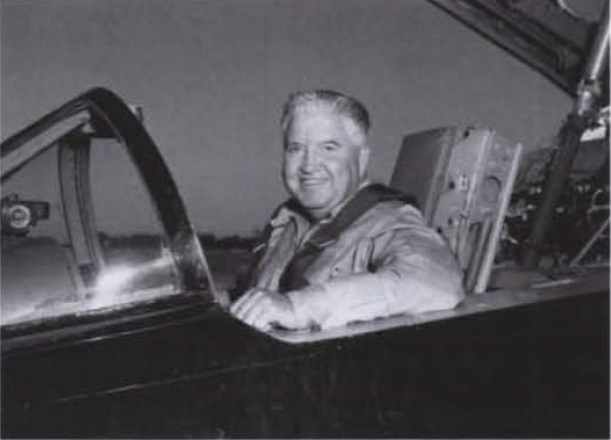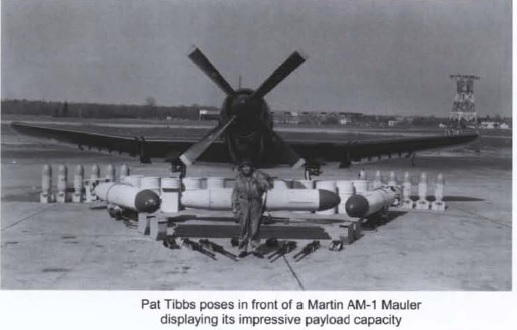Click on any preview to enlarge the picture. Most of the pictures are high resolution, and may require some time and one or more click to be displayed at full size.
Fate click su qualsiasi anteprima per ingrandire l'immagine. La maggior parte delle immagini è ad alta risoluzione, e può richiedere un po' di tempo e uno o più click per essere visualizzata a pieno formato.
Recently the Martin Museum received a donation of artifacts belonging to one of Martin's most important men, O. E. "Pat" Tibbs.
The donation came from Pamela Nuhn and her husband Kelly of Lexington, Kentucky. Pamela is the surviving niece of Pat Tibbs, who was an experimental test pilot and flew many of Martin's most famous aircraft.
His artifacts, including his flight helmet, awards, models, and photos are now part of a new display within the museum.
Born on an Oklahoma farm in 1909, Orville Edwin Tibbs was, by the suggestion of his Aunt Nora Hearn, named after Orville Wright, the pioneering aviator, who along with his brother Wilbur, was making headline news with their flying achievements in those years. Aviation was still in its infancy, but it was getting around fast. It was on that same farm in 1917 that Orville Edwin, or Pat as his friends always called him, saw his first airplane flying overhead. After he saw that airplane he knew he wanted to fly. Pat, the farm boy from Pottawatomie County, would follow in his namesake's footsteps and push the envelope of aviation technology even further.
Pat Tibbs went to Abilene Christian College and Texas Tech before being accepted in the primary flight training program at Randolph Field where he graduated with the first class of pilots. In October 1932 he was commissioned as a 2nd Lieutenant in the Army Air Corps at Kelly Field. For the next two years with the 12th Observation Group one of his jobs would be to fly airmail for the Army between Omaha and Cheyenne.
After a stint being a barnstormer, flight instructor, aerial mapper, and one more term of service in the Air Corps, Pat Tibbs decided to become a test pilot.
The year was 1935, the same year he married Thelma Holland.
His wife Thelma was always present when Tibbs was making a first flight. Tibbs stated, "She is my good luck charm."
After a short stint testing army trainer aircraft with Southern Aircraft, Pat Tibbs accepted an offer to work at the Glenn L. Martin Company as part of the production flight test crew and began his new job in December, 1941, a few days after Pearl Harbor. There at the Martin Company, Tibbs' career would really take off.
Pat Tibbs was a large man. At six feet tall and 230 pounds, a newspaper noted he was built like a fullback and looked like a successful banker. Many were surprised to find he was a test pilot with over one hundred aircraft types flown over his career. Tibbs was the first to fly many of the new aircraft rolling off of the Martin lines including the B-26 Marauder, P5M-1/2 Marlin, XP4M-1 Mercator, XPBM-5A Mariner, XBTM-1 Mauler, JRM Mars, Martin 202, XB-48, XB-51, and B-57 A Canberra.
Tibbs even took off down the runway after hours in his Oldsmobile. Drag racing with his pilot buddies George Rodney and Fuzz Furman; Tibbs usually lost the races until he installed a turbo in his Olds.
Pat Tibbs stated once that there was only one aircraft he couldn't fly, a German Focke-Wulf fighter.
Pat said, "I started to test it, but I couldn't fit into the cockpit. I was too tall and couldn't pull the canopy shut over my head. I wonder if the Nazis used midgets to pilot those FockeWulf bombers."
Tibbs was also highly knowledgeable in aeronautical engineering and felt that any worthwhile test pilot could give a reliable analysis of the aircraft after the first flight. This skill and dedication meant that by March 1943 Tibbs had become chief production test pilot, and two months later became chief test pilot and airport operations manager.
In 1958 Tibbs ended his days as a test pilot. For a brief while he headed Martin's forces in Europe and worked at Martin's Denver facility.
The Martin Company was now into aerospace and electronics instead of aircraft. In 1960 Tibbs was promoted to Vice President and General Manager of Martin-Cocoa
Division located at Cape Canaveral.
It was there that he was in charge of the launch operations of Martin's new missiles like Mace and Pershing and the Titan series rockets. Titan rockets became the mainstay ICBM for the United States and also served as the launch vehicle for the NASA Gemini space program, which Tibbs was also involved in. In fact Tibbs was a flying friend with Astronaut Gordon Cooper's father, Leroy Gordon Cooper Sr., back home in Oklahoma in 1934. 10 pairs of astronauts went into orbit under Tibbs watch.
Pat Tibbs retired from Martin in 1967 and moved back to his home state of Oklahoma. There the avid golf player still took to the air, flying general aviation.
O. E. 'Pat' Tibbs passed away on August 14, 1982 at the age of 73.
Recentemente il Martin Museum ha ricevuto una donazione di oggetti appartenenti a uno degli uomini più importanti della Martin, O. E. "Pat" Tibbs.
La donazione è arrivata da Pamela Nuhn e da suo marito Kelly di Lexington, Kentucky. Pamela è la nipote di Pat Tibbs, che era un pilota collaudatore sperimentale e ha pilotato molti dei velivoli più famosi della Martin.
I suoi oggetti, tra cui il casco da volo, premi, modelli e foto fanno ora parte di una nuova mostra all'interno del museo.
Nato in una fattoria dell'Oklahoma nel 1909, a Orville Edwin Tibbs, su suggerimento di sua zia Nora Hearn, fu assegnato il nome di Orville Wright, l'aviatore pionieristico, che in quegli anni, insieme a suo fratello Wilbur, faceva notizia sulle prime pagine con i successi nel volo. L'aviazione era ancora agli inizi, ma stava crescendo rapidamente. Fu nella stessa fattoria nel 1917 che Orville Edwin, o Pat come lo chiamavano sempre i suoi amici, vide il suo primo aereo volare sopra di loro. Dopo aver visto quell'aereo, capì di voler volare. Pat, il ragazzo di campagna della contea di Pottawatomie, avrebbe seguito le orme del suo omonimo e avrebbe contribuito all'ulteriore sviluppo della tecnologia aeronautica.
Pat Tibbs frequentò l'Abilene Christian College e il Texas Tech prima di essere accettato nel programma di addestramento di volo primario al Randolph Field dove si laureò con la prima classe di piloti. Nell'ottobre del 1932 fu incaricato come sottotenente nel Corpo Aereo dell'Esercito a Kelly Field. Per i successivi due anni con il 12° gruppo di osservazione, uno dei suoi compiti sarebbe stato quello di far volare la posta aerea per l'esercito tra Omaha e Cheyenne.
Dopo essere stato un barnstormer, un istruttore di volo, un mappatore aereo e dopo un altro periodo di servizio nell'Air Corps, Pat Tibbs decise di diventare pilota collaudatore.
L'anno era il 1935, lo stesso anno in cui sposò Thelma Holland.
Sua moglie Thelma era sempre presente quando Tibbs faceva un primo volo. Tibbs dichiarò: "È il mio portafortuna".
Dopo un breve periodo di collaudo di aerei da addestramento dell'esercito con la Southern Aircraft, Pat Tibbs accettò un'offerta di lavoro presso la Glenn L. Martin Company come parte dell'equipaggio per i test di volo di produzione e iniziò il suo nuovo lavoro nel dicembre 1941, pochi giorni dopo Pearl Harbor. Lì alla Martin Company, la carriera di Tibbs sarebbe davvero decollata.
Pat Tibbs era un uomo grosso. Con un metro e ottanta di altezza e 104 chili, un giornalista osservò che era costruito come un fullback e che sembrava un banchiere di successo. Molti furono sorpresi di scoprire che era un pilota collaudatore che aveva volato su oltre un centinaio di tipi di aeromobili durante la sua carriera. Tibbs fu il primo a far volare molti dei nuovi velivoli che uscivano dalle linee di Martin tra cui B-26 Marauder, P5M-1/2 Marlin, XP4M-1 Mercator, XPBM-5A Mariner, XBTM-1 Mauler, JRM Mars, Martin 202, XB-48, XB-51 e B-57A Canberra.
Tibbs è addirittura decollato in pista, dopo ore nella sua Oldsmobile, facendo drag racing con i suoi amici piloti George Rodney e Fuzz Furman. Di solito Tibbs perdeva le gare, fino a quando non installò un turbo nella sua Olds.
Pat Tibbs dichiarò una volta che c'era un solo aereo che non era riuscito a pilotare, un caccia tedesco Focke-Wulf.
Pat disse: "Ho iniziato a provarlo, ma non riuscivo a entrare nella cabina di pilotaggio. Ero troppo alto e non riuscivo a chiudere il tettuccio sopra la mia testa. Mi chiedo se i nazisti usassero i nani per pilotare quei bombardieri Focke-Wulf".
Tibbs era anche molto esperto in ingegneria aeronautica e riteneva che qualsiasi pilota collaudatore valido doveva essere in grado fornire un'analisi affidabile dell'aeromobile dopo il primo volo. Questa abilità e dedizione significarono che nel marzo del 1943 Tibbs divenne il collaudatore capo della produzione e, due mesi dopo, divenne capo collaudatore e responsabile delle operazioni aeroportuali.
Nel 1958 Tibbs finì i suoi giorni come pilota collaudatore. Per un breve periodo guidò le forze di Martin in Europa e lavorò nella struttura di Martin a Denver.
La Martin Company era ora nel settore aerospaziale ed elettronico invece che in quello degli aeroplani. Nel 1960 Tibbs fu promosso Vice Presidente e Direttore Generale della Divisione Martin-Cocoa, situata a Cape Canaveral.
Fu lì che si occupò delle operazioni di lancio dei nuovi missili di Martin come Mace e Pershing e dei missili della serie Titan. I razzi Titan sono diventati il principale ICBM per gli Stati Uniti e sono stati anche il veicolo di lancio per il programma spaziale Gemini della NASA, in cui era coinvolto anche Tibbs.
In realtà Tibbs era compagno di volo del padre dell'astronauta Gordon Cooper, Leroy Gordon Cooper Sr., a casa sua in Oklahoma nel 1934. 10 coppie di astronauti andarono in orbita sotto la supervisione di Tibbs.
Pat Tibbs si ritirò dalla Martin nel 1967 e tornò nel suo stato d'origine dell'Oklahoma. Lì l'avido giocatore di golf ha ripreso l'aria, volando in aviazione generale.
O. E. 'Pat' Tibbs è scomparso il 14 agosto 1982, all'età di 73 anni.


❦